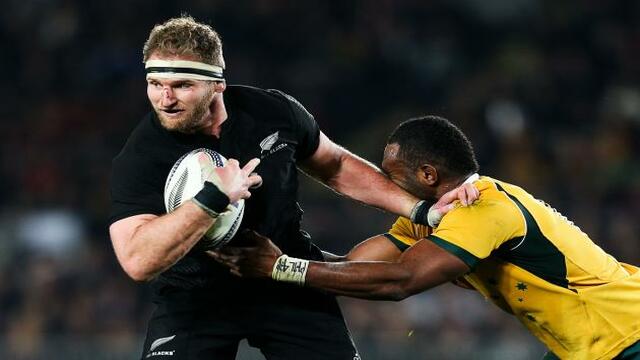From preparation to Execution
Last week’s Test match at Wellington between New Zealand and Australia provided a perfect example of how to draw the ‘story’ of a back-line move through a full week of preparation, and all the way to match-day execution.
Wayne Smith’s coaching modules on Decision-making – attack, and Back moves provide the background for the All Blacks’ second try of the game in the 22nd minute. In those modules, Wayne Smith highlights the need for:
• Scouting & analysis of opposition weaknesses
• Use of ‘hiding’ and ‘holding’ players in combination on attack
• Attacking the same target space (until it is successfully defended)
Scouting & analysis of opposition weaknesses In the build-up the match, the All Black coaching staff would have been looking at ways to unlock Australia’s rush defence. Particularly from set-piece, that defence has a very specific character:

As this snapshot shows, the Wallabies like to drive upfield in a hard ‘man’ defence, and for this reason they replace their outside-half with Michael Hooper in the 10 channel from lineout, in order to pack maximum power into the frontal tackles they expect to make. Hooper is probably the most dominant tackler in the Wallaby playing group.
If the second pass is made by the attacking side, the outside centre (Samu Kerevi) is typically required to jam in from outside centre and make a tackle behind the advantage line rather than drift out towards touch, and it is this tendency which I believe the All Black coaches decided to exploit.
Use of ‘hiding’ & ‘holding’ players on attack In his two modules, Wayne Smith explains how ‘hiding’ players (penetrators who are trying to mask the true target space and hit into it late) and ‘holding’ players (decoys who are trying to attract the eyes of the defenders and open up that space) can interact within a back-line move.
The back-line move observed from behind the posts shows how the theory works in practice:
The key defenders are the same as in the snapshot – Hooper in the 10 channel, replacement #22 Reece Hodge at 12, and Kerevi at outside centre.
• Positioning of #10 Beauden Barrett. Although the true aim is to run Barrett on a long arc around Kerevi, in the initial stages that intent is carefully ‘hidden’. Beauden Barrett starts inside the 1st receiver on the play, Anton Lienert-Brown, initially engaging the attention of Michael Hooper:

Notably Barrett doesn’t start to move outside until Lienert-Brown has received the pass from Aaron Smith.
• Lienert-Brown & Fekitoa as ‘holding’ players. The two main holding players are 1st receiver Lienert-Brown and the New Zealand #13 Malakai Fekitoa.

Lienert-Brown has his right foot up and his body angled inside, and so he is attracting the ‘eyes’ of both Hooper and Hodge. Fekitoa likewise starts his run at an acute angle inside, an angle he knows will be mirrored by Kerevi in the Wallaby defensive pattern. Kerevi duly takes one big, jagging step inwards.
• The ‘hiding’ attacker revealed! The success of Lienert-Brown and Fekitoa’s holding operation is only revealed when Barrett receives the second pass en route to the outside.

Hooper, Hodge and Kerevi are all condensed into about five metres of space and the defender outside them (Dane Haylett-Petty) is not even in shot – so the target area for Barrett to run into has been successfully maximised.
• Correct use of decoys ahead of the ball. As Fekitoa hits the line and Barrett receives the pass, the All Black centre runs through the gap between Hodge and Kerevi. As Wayne Smith pointed out in an article he wrote for The Rugby Site four years ago, the decoy has to be in exactly the right spot to avoid attracting the referee’s attention:
“Almost every team in the world now gets their fly-half to pass to a man coming from deep behind a couple of decoy runners. Those decoy runners frequently obstruct the defenders at least visually, and very often physically.
This is something I would like the IRB to clarify. When the Aussies first brought this trend across from rugby league, the receiver had to catch the ball outside the line of the decoy runners. If a player caught the ball before being on the outside of the decoys, it was a penalty. The receiver is now carrying the ball behind the decoy runners, almost like a running back following a blocking fullback in American Football."
When he receives the ball, Barrett is one body’s width beyond Fekitoa’s outside shoulder, and as a result his trip on Kerevi does not attract the penalty for interference that might well have been the result, had Barrett caught the ball directly behind or to the inside of his team-mate.


Attacking the same target space There was a degree of repetition in attacking intent, because the All Blacks had used a miss pass to attract the same inward movement/rush on the second pass earlier in the game:
Here the ‘holding’ player Brodie Retallick attracts the rush from #2 Stephen Moore but the pass goes straight to Owen Franks outside him. All the remaining Wallaby defenders ‘domino’ down to the inside leaving space wide for Israel Dagg to convert his second opportunity of the night.
Summary
As the German writer W.G.Sebald once said, “Tiny details imperceptible to us decide everything!”
The devil is truly in the detail in both Wayne Smith’s coaching modules and their practical applications at the highest level.
Accurate reports of enemy activity are required to identify potential weaknesses in their systems, the right combination of decoys and penetrators found to create uncertainty and only tip off the true area of attack at the last possible moment.
The timing of runs and passes related to decoys must be exact, and the target space ruthlessly exploited again and again until the defence reacts and plugs the gap.
The story from blackboard to on-field play can be an inspiring adventure!


